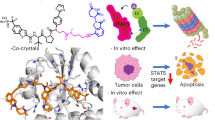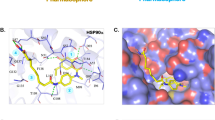Abstract
Coexpression of multiple shRNAs can simultaneously inhibit multiple genes or target multiple sites on a single gene. These approaches can be used for dissecting complex signaling pathways and even be applied to targeting multiple genes in cancer therapy. Here we established a simple and efficient multiple shRNAs expression system based on pSUPER, the most popular expression vector in mammalian cells. A series of head-to-tail tandem array multiple shRNAs expression vectors were constructed containing different combinations of six shRNA expression cassettes targeting genes involved in cell proliferation and survival pathways: Bcl-2, Survivin, Akt1, Erk2, CyclinE and NFκB. In HeLa and HEK293 cells, the multiple shRNAs expression constructs could efficiently and simultaneously induce inhibition of all six genes. We further evaluated the inhibition effects of the multiple shRNAs expression vectors on the human prostate cancer cell line PC3, which contains different cell variants with distinct oncogenic signaling alterations. The results revealed that the multiple shRNAs expression system could inhibit all six genes and was much more efficient in inducing apoptosis in the PC3 cells. Our results suggest that the multitarget shRNAs expression system could be an effective strategy in cancer therapy and be applied to any other DNA vector-based shRNA expression system.
This is a preview of subscription content, access via your institution
Access options
Subscribe to this journal
Receive 12 print issues and online access
$259.00 per year
only $21.58 per issue
Buy this article
- Purchase on Springer Link
- Instant access to full article PDF
Prices may be subject to local taxes which are calculated during checkout










Similar content being viewed by others
References
Dykxhoorn DM, Novina CD, Sharp PA . Killing the messenger: short RNAs that silence gene expression. Nat Rev Mol Cell Biol 2003; 4: 457–467.
Grimm D, Kay MA . Combinatorial RNAi: a winning strategy for the race against evolving targets? Mol Ther 2007; 15: 878–888.
Siolas D, Lerner C, Burchard J, Ge W, Linsley PS, Paddison PJ et al. Synthetic shRNAs as potent RNAi triggers. Nat Biotechnol 2005; 23: 227–231.
Wu MT, Wu RH, Hung CF, Cheng TL, Tsai WH, Chang WT . Simple and efficient DNA vector-based RNAi systems in mammalian cells. Biochem Biophys Res Commun 2005; 330: 53–59.
Hanahan D, Weinberg RA . The hallmarks of cancer. Cell 2000; 100: 57–70.
Nelson WG, De Marzo AM, Isaacs WB . Prostate cancer. N Engl J Med 2003; 349: 366–381.
Chung KH, Hart CC, Al-Bassam S, Avery A, Taylor J, Patel PD et al. Polycistronic RNA polymerase II expression vectors for RNA interference based on BIC/miR-155. Nucleic Acids Res 2006; 34: e53.
Greber D, Fussenegger M . Multi-gene engineering: simultaneous expression and knockdown of six genes off a single platform. Biotechnol Bioeng 2007; 96: 821–834.
Jazag A, Kanai F, Ijichi H, Tateishi K, Ikenoue T, Tanaka Y et al. Single small-interfering RNA expression vector for silencing multiple transforming growth factor-beta pathway components. Nucleic Acids Res 2005; 33: e131.
O'Grady M, Raha D, Hanson BJ, Bunting M, Hanson GT . Combining RNA interference and kinase inhibitors against cell signalling components involved in cancer. BMC Cancer 2005; 5: 125.
Sun D, Melegari M, Sridhar S, Rogler CE, Zhu L . Multi-miRNA hairpin method that improves gene knockdown efficiency and provides linked multi-gene knockdown. Biotechniques 2006; 41: 59–63.
Wang S, Shi Z, Liu W, Jules J, Feng X . Development and validation of vectors containing multiple siRNA expression cassettes for maximizing the efficiency of gene silencing. BMC Biotechnol 2006; 6: 50.
Xia XG, Zhou H, Xu Z . Multiple shRNAs expressed by an inducible pol II promoter can knock down the expression of multiple target genes. Biotechniques 2006; 41: 64–68.
Jiang M, Milner J . Bcl-2 constitutively suppresses p53-dependent apoptosis in colorectal cancer cells. Genes Dev 2003; 17: 832–837.
Carvalho A, Carmena M, Sambade C, Earnshaw WC, Wheatley SP . Survivin is required for stable checkpoint activation in taxol-treated HeLa cells. J Cell Sci 2003; 116: 2987–2998.
Katome T, Obata T, Matsushima R, Masuyama N, Cantley LC, Gotoh Y et al. Use of RNA interference-mediated gene silencing and adenoviral overexpression to elucidate the roles of AKT/protein kinase B isoforms in insulin actions. J Biol Chem 2003; 278: 28312–28323.
Liu X, Yan S, Zhou T, Terada Y, Erikson RL . The MAP kinase pathway is required for entry into mitosis and cell survival. Oncogene 2004; 23: 763–776.
Filleur S, Courtin A, Ait-Si-Ali S, Guglielmi J, Merle C, Harel-Bellan A et al. SiRNA-mediated inhibition of vascular endothelial growth factor severely limits tumor resistance to antiangiogenic thrombospondin-1 and slows tumor vascularization and growth. Cancer Res 2003; 63: 3919–3922.
Guo J, Verma UN, Gaynor RB, Frenkel EP, Becerra CR . Enhanced chemosensitivity to irinotecan by RNA interference-mediated down-regulation of the nuclear factor-kappaB p65 subunit. Clin Cancer Res 2004; 10: 3333–3341.
Brummelkamp TR, Bernards R, Agami R . A system for stable expression of short interfering RNAs in mammalian cells. Science 2002; 296: 550–553.
Rokhlin OW, Bishop GA, Hostager BS, Waldschmidt TJ, Sidorenko SP, Pavloff N et al. Fas-mediated apoptosis in human prostatic carcinoma cell lines. Cancer Res 1997; 57: 1758–1768.
Kaufmann SH, Desnoyers S, Ottaviano Y, Davidson NE, Poirier GG . Specific proteolytic cleavage of poly(ADP-ribose) polymerase: an early marker of chemotherapy-induced apoptosis. Cancer Res 1993; 53: 3976–3985.
Simbulan-Rosenthal CM, Rosenthal DS, Iyer S, Boulares AH, Smulson ME . Transient poly(ADP-ribosyl)ation of nuclear proteins and role of poly(ADP-ribose) polymerase in the early stages of apoptosis. J Biol Chem 1998; 273: 13703–13712.
Hung CF, Lu KC, Cheng TL, Wu RH, Huang LY, Teng CF et al. A novel siRNA validation system for functional screening and identification of effective RNAi probes in mammalian cells. Biochem Biophys Res Commun 2006; 346: 707–720.
Grimm D, Streetz KL, Jopling CL, Storm TA, Pandey K, Davis CR et al. Fatality in mice due to oversaturation of cellular microRNA/short hairpin RNA pathways. Nature 2006; 441: 537–541.
Singh RP, Agarwal R . Mechanisms of action of novel agents for prostate cancer chemoprevention. Endocr Relat Cancer 2006; 13: 751–778.
Bitko V, Musiyenko A, Shulyayeva O, Barik S . Inhibition of respiratory viruses by nasally administered siRNA. Nat Med 2005; 11: 50–55.
Gitlin L, Karelsky S, Andino R . Short interfering RNA confers intracellular antiviral immunity in human cells. Nature 2002; 418: 430–434.
Li BJ, Tang Q, Cheng D, Qin C, Xie FY, Wei Q et al. Using siRNA in prophylactic and therapeutic regimens against SARS coronavirus in Rhesus macaque. Nat Med 2005; 11: 944–951.
Novina CD, Murray MF, Dykxhoorn DM, Beresford PJ, Riess J, Lee SK et al. siRNA-directed inhibition of HIV-1 infection. Nat Med 2002; 8: 681–686.
Palliser D, Chowdhury D, Wang QY, Lee SJ, Bronson RT, Knipe DM et al. An siRNA-based microbicide protects mice from lethal herpes simplex virus 2 infection. Nature 2006; 439: 89–94.
Boden D, Pusch O, Lee F, Tucker L, Ramratnam B . Human immunodeficiency virus type 1 escape from RNA interference. J Virol 2003; 77: 11531–11535.
Gitlin L, Stone JK, Andino R . Poliovirus escape from RNA interference: short interfering RNA-target recognition and implications for therapeutic approaches. J Virol 2005; 79: 1027–1035.
Wu HL, Huang LR, Huang CC, Lai HL, Liu CJ, Huang YT et al. RNA interference-mediated control of hepatitis B virus and emergence of resistant mutant. Gastroenterology 2005; 128: 708–716.
Chang LJ, Liu X, He J . Lentiviral siRNAs targeting multiple highly conserved RNA sequences of human immunodeficiency virus type 1. Gene Therapy 2005; 12: 1133–1144.
Henry SD, van der Wegen P, Metselaar HJ, Tilanus HW, Scholte BJ, van der Laan LJ . Simultaneous targeting of HCV replication and viral binding with a single lentiviral vector containing multiple RNA interference expression cassettes. Mol Ther 2006; 14: 485–493.
ter Brake O, Konstantinova P, Ceylan M, Berkhout B . Silencing of HIV-1 with RNA interference: a multiple shRNA approach. Mol Ther 2006; 14: 883–892.
Wu K, Mu Y, Hu J, Lu L, Zhang X, Yang Y et al. Simultaneously inhibition of HIV and HBV replication through a dual small interfering RNA expression system. Antiviral Res 2007; 74: 142–149.
Acknowledgements
This work was supported by grant NSC-95-2752-B-006-004-PAE from the National Science Council, Taiwan, ROC (to WT Chang) and grant DOH-TD-B-111-004 from the Department of Health, Taiwan, ROC (to CY Chou).
Author information
Authors and Affiliations
Corresponding author
Rights and permissions
About this article
Cite this article
Cheng, T., Teng, C., Tsai, W. et al. Multitarget therapy of malignant cancers by the head-to-tail tandem array multiple shRNAs expression system. Cancer Gene Ther 16, 516–531 (2009). https://doi.org/10.1038/cgt.2008.102
Received:
Revised:
Accepted:
Published:
Issue Date:
DOI: https://doi.org/10.1038/cgt.2008.102
Keywords
This article is cited by
-
Conservation and novelty in the microRNA genomic landscape of hyperdiverse cichlid fishes
Scientific Reports (2019)
-
Loss of the respiratory enzyme citrate synthase directly links the Warburg effect to tumor malignancy
Scientific Reports (2012)
-
A direct comparison of strategies for combinatorial RNA interference
BMC Molecular Biology (2010)



